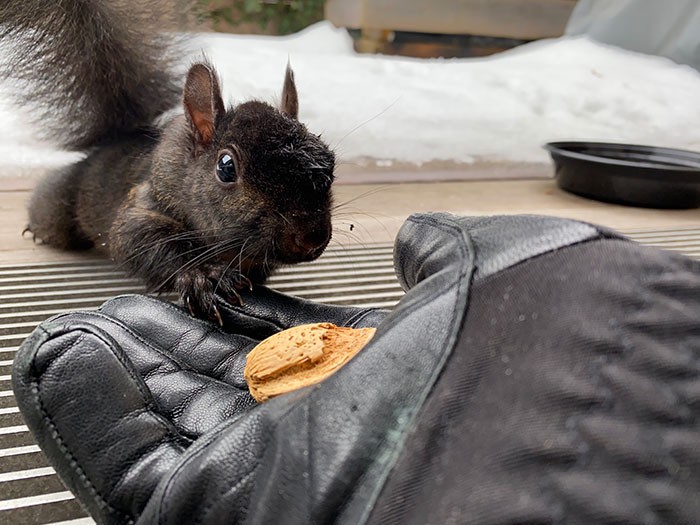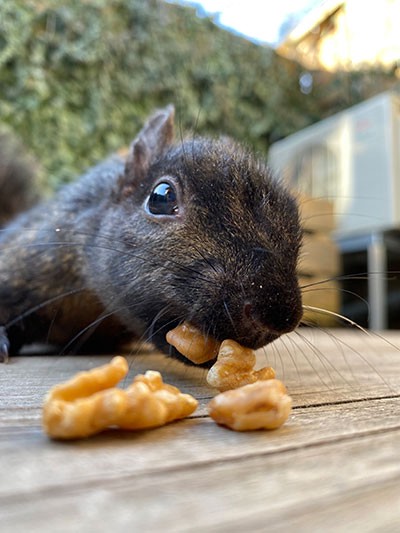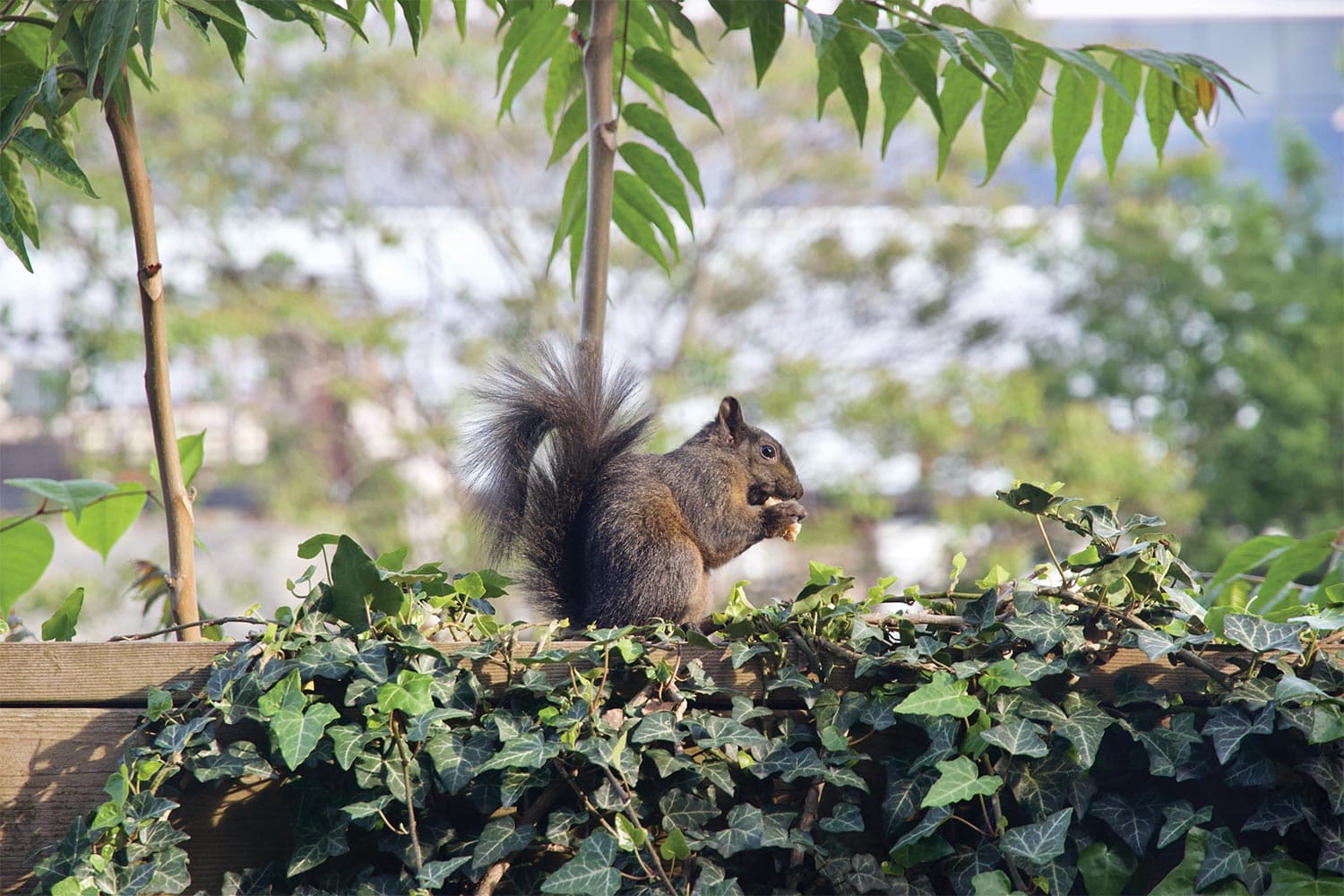If Feeding Wildlife Is Wrong, Why Does it Feel So Right?
Backyard squirrels made me ponder the pleasures of wildlife feeding, and what we should do instead.
During the first winter of the pandemic, author Kat Tancock began leaving food out for the squirrels in her backyard.
It started with some leftover popcorn. I’d been ready to dump it in the green bin when I remembered the squirrels and tossed it in one of the backyard planters they love to dig in instead. It was the lonely first winter of the pandemic, Toronto had been locked down for what seemed like forever, and the sight of the furry rodents devouring our leftovers on the other side of the patio door — just inches away from us, when we got really close — brought us immense amounts of joy.
So much joy, in fact, that it inevitably didn’t end with the popcorn.
At first we were circumspect, scattering peanuts on the deck and waiting for the foragers to find them. Then we started buying tree nuts in the shell — squirrel health food! — and leaving them on the edge of the planters, right by the window, where we could watch them roll them in their little paws, testing for quality. That, of course, led to hand-feeding. Nuts in a gloved hand, hand on the ground, we slowly trained them to trust us.
Patches, who we named for the chunks of fur she was missing, was the most daring, warily approaching to retrieve her snack then nibbling it not far away, her eyes alert and watching. Fraidy took longer to get close, evasively moving forward and back before darting in for a quick retrieval then retreating out of reach. (Which is exactly how he got his name.) And Notchtail, with a gap in his furry tail, was the most anti-social of the three. He would rush in and chase the others away before acquiring the prize for himself.
We knew it was wrong. But like so many things, it was easy to rationalize.
We knew it was wrong. Feeding wildlife is almost universally frowned upon, and for good reason. But like so many things, it was easy to rationalize: this is an urban backyard, roughly 2 by 4 metres and backing onto a parking lot, and these are urban squirrels. (Technically the species we get in our backyard is the eastern grey, though more often than not they’re black, and — once in a blue moon — white.) We often see them perched on our fence dining on crusts of bread, or nibbling the edible parts clinging to a discarded muffin wrapper or Tetra Pak.
Once, I sat completely rapt watching a young squirrel carefully, imperfectly, bury a poppy seed bagel into our wall of ivy. It sat there for days, about a metre and a half from the ground and half a metre below the top of the fence, until it suddenly disappeared again — retrieved by whom, I’ll never know.
The fun lasted until the warm days of spring. The patio door is next to my dining-table home-office setup, and I was constantly being distracted by inquisitive faces peering in at me, stretching up for a good view, tapping tiny claws on the glass. I couldn’t leave the door open for fresh air without worrying about an enterprising squirrel entering to investigate. And then one day I opened the door to place some hazelnuts on the table for Patches, who we suspected was pregnant. She was so eager and impatient, she leapt up and toward me before I could make a move, then scurried away at my shout. No one was hurt, no damage was done, but it was the wake-up call I needed. And so we stopped.

Tancock and her partner named the squirrels who visited regularly, and eventually some of them became comfortable enough to eat out of their hands.
It was Patches I thought of when I read in October about Zuzana Stevikova, who was fined C$60,000 for feeding bears on her property in Whistler, BC. In the summer of 2018, according to a CBC report, Stevikova had been buying apples, carrots, pears, and eggs by the caseload then offering them to the bears, one of whom she called Lilly. She was apparently concerned they were too skinny, and told one person “she was feeding the bears so that people in Whistler would not complain about them and the conservation officers would not kill them.” Unfortunately, a fed bear is a dead bear, as they say, and Stevikova’s guests were indeed put down, though not without controversy.
It’s a similar story with urban coyotes. Here in Toronto we spot them occasionally, but they haven’t made the news in any major way, though people are feeding them. I’ve also heard neighbourhood gossip — alas, unconfirmable — of a woman stalking a coyote with a leash and collar in hand, I suppose hoping to tame it somehow. But in Vancouver last year, the situation was much more serious.
From December 2020 through to last fall, more than 45 people were bitten by coyotes in the city’s Stanley Park. The attacks were shocking in that they were so unusual, experts told the Globe and Mail, adding that they were almost certainly a result of the animals being fed by humans. In the end, authorities killed 11 coyotes and arrested two people for feeding them. What comes next? The hope, University of Calgary coyote researcher Shelley Alexander told Globe reporter Frances Bula, is that when a new group of coyotes moves in — as they will — no one feeds them, and they continue their wild existence, next to, but separate from, humans.
If you’d asked me a few years ago, I would almost certainly have been dismissive of Stevikova and those like her who continue to feed wildlife either in defiance or ignorant of all guidelines to the contrary. But thanks to my squirrel neighbours, I’ve had a bit of a change of heart.
In terms of negative effects to the animals and the community, there’s a big difference between feeding a bear or a coyote and feeding a squirrel. But the emotional resonance is similar. As I’d come to know the squirrels as individuals, they’d become a part of my life, and I a part of theirs. It hurt my heart watching Patches and Fraidy come by looking for nuts after we’d stopped distributing them, confused about what had changed.
When Patches appeared one day with two smaller squirrels chasing her and each other and occasionally trying to nurse, I felt partially responsible, like my walnuts and almonds had helped fuel her healthy pregnancy. So I have become empathetic to those who, like me, have given into their urge to support another living creature, albeit with much higher stakes than mine. It seems a need to nurture wildlife is part of our wiring. We want to connect with wild animals, and to help them thrive. The question is, how can we harness that desire for good?
The realities of climate change and habitat loss mean that it’s harder than ever for our animal cousins to live a life free of human intervention. As journalist Emma Marris writes in her book Wild Souls, we might even have a moral imperative to intervene in cases where wildlife is suffering due to human actions, as a sort of recompense for the harm we have caused. But that’s easier said than done.
We want to connect with wild animals, and to help them thrive. How can we harness that desire for good?
Feeding animals in the wild isn’t necessarily a simple prospect, Marris notes — imagine the logistics of producing and safely distributing regular meals for a whole host of endangered species — and there can be both moral and physical consequences we might not have anticipated. Bird feeders, for instance, are helpful to increase survival rates. But they also spread disease and can alter birds’ behaviour. And the scattered seeds attract other animals like rats, skunks, and deer, which the Nova Scotia Department of Natural Resources and Renewables points out are hosts for the ticks that carry Lyme disease.
As for larger animals like polar bears, Marris says, the issue gets much more complicated. If polar bears’ very existence is threatened by climate change — and while it is, she says, it’s not (yet) to the degree people often think — then we might have an obligation to them, a collective responsibility not to let them starve to extinction. But besides the immense practical difficulties, that would mean finding meat for them to eat, probably seals, and harming the seals to save the bears… in other words, playing God.
“Collectively, we’ve made the world that all these sentient creatures inhabit; we have at least some duty to them,” Marris writes. “What that duty entails continues to bedevil me.”
Untangling what’s right and what’s needed when it comes to feeding wild animals is a philosophical and ecological conundrum that’s beyond my skill set. But there is one solution I know of that’s both simple and effective: helping wildlife continue to feed themselves. Saving existing habitats is a huge part of this, but so is building new ones — a process called “rewilding.” Rewilding can’t fix everything, but it can fix a lot of things, and one major benefit is its potential to get people involved and engaged.
Rewilding means supporting bird populations not by hanging feeders full of imported seed, but by planting trees and shrubs that provide the creatures’ natural food sources. It means filling our balconies, yards, and parks with dense ecosystems of native species, including flowering plants that pollinators love, and trees like oak and hazelnut that provide both food and shelter to our squirrel friends. It means cleaning up our yards and parks less often, and letting snags and fallen logs decay naturally.
It means buffering our agricultural land with hedgerows, wetlands, meadows, and woodlands protected from harmful chemicals and machinery, and left alone to stay wild, to ensure there is space for local and migratory wildlife to live, breed, and feed. It means removing fences so animals can travel as they need to. And at the larger scale, it means rethinking how we log and clear land, and ensuring that remaining habitat is connected rather than fragmented, through projects like the Yellowstone to Yukon Conservation Initiative. In short, we can feed wild animals. We just need to do it indirectly.

When Tancock caught a squirrel sneaking inside the house, it was time to stop feeding them for good.
I have to confess, as happens with many bad habits, our first attempt to quit feeding the squirrels didn’t stick. We were away for much of the summer and the squirrels were too, doing whatever squirrels do far up in the trees. But then fall came, and Patches returned to our backyard, inquisitive as ever.
We cracked. One walnut, and she was back to the old routine, checking in at the window several times a day. It didn’t last long, though — one afternoon, I caught her sneaking in the door I’d left open a crack for fresh air. That day, we quit for good. With one exception: we’ve been leaving a small water dish out back, valuable for squirrels on both the icy and the super-hot days. Patches and, we think, a couple of her children will drop by periodically to drink from it, and then move on. She’ll look up at us occasionally. I like to think she’s saying “thank you.”
Print Issue: Spring 2022
Print Title: Squirrels Don't Need Bagels
